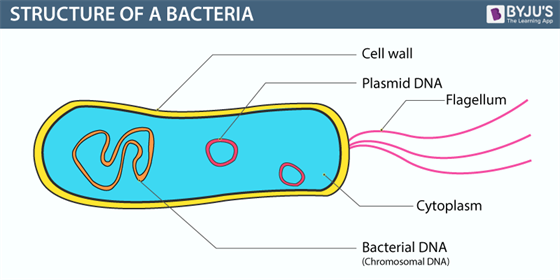Bacteria
Bacteria are single-celled microscopic creatures. They belong to a separate kingdom called Monera. These monerans usually lack a true nucleus. The round DNA structure and the absence of membrane-bound organelles are vital features, differentiating them from the other class.
Bacterias exist in millions and are found everywhere. They can be beneficial as well as harmful. They are usually considered disease-causing organisms. But, some are even used in modern therapeutic processes.

Amoeba
Amoeba is a single-celled eukaryotic organism. They have no definite shape and move around with the help of pseudopodia (false feet). They extend and contract their pseudopodia for movement.
Moreover, they are freshwater organisms. They belong to the kingdom Protista, which groups unicellular eukaryotes. Their single cell is responsible for most functions like respiration, absorption, reproduction, etc. It is covered with a jelly-like cytoplasm, which embeds food vacuole and contractile vacuole. Furthermore, they multiply by means of binary fission (asexual reproduction).

Differences between Bacteria and Amoeba
Bacteria |
Amoeba |
|
Bacteria are Prokaryotes. |
Amoeba is a Eukaryote. |
|
They lack a few organelles and also true nuclei. |
These eukaryotes have both organelles and nuclei. |
|
They belong to the kingdom Monera. |
They belong to the kingdom Protista, which houses unicellular eukaryotes. |
|
They are tiny microscopic structures found in various shapes and sizes. |
Amoeba is a microscopic irregular structure. But, they are comparatively larger than the bacteria. |
|
They are found everywhere and can tolerate a wide range of temperatures. Example – Extremophiles. |
Amoeba can also be found in most places. But, they cannot thrive in cold conditions. Their optimal temperature is 46 degrees celsius. |
Also Read: Differences between Prokaryotes and Eukaryotes
Frequently Asked Questions
What are the similarities between bacteria and amoeba?
Both bacteria and amoeba are microscopic structures. Also, both reproduce by asexual means, which is usually binary fission. Apart from these, there is no similarity between these two unique organisms.
What is the structure of an amoeba?
The three main structures of an amoeba are – a plasma membrane (outer covering), a jelly-like cytoplasm and a true nucleus.
- The plasma is composed of protein and fat molecules.
- The cytoplasm is divided into endoplasm (inner portion) and ectoplasm (outer part).
- They have cell organelles such as mitochondria, food vacuole, contractile vacuole, Golgi etc.,
- Their pseudopodia or projection-like structure helps in their movement.
Can amoeba cause disease?
Yes, the amoeba can also cause diseases. They usually attack the intestine and cause dysentery, ulcers, etc. Entamoeba histolytica is a well-known organism that causes amoebiasis.
Refer: Amoebiasis
Visit BYJU’S Biology for more interesting topics.
Comments